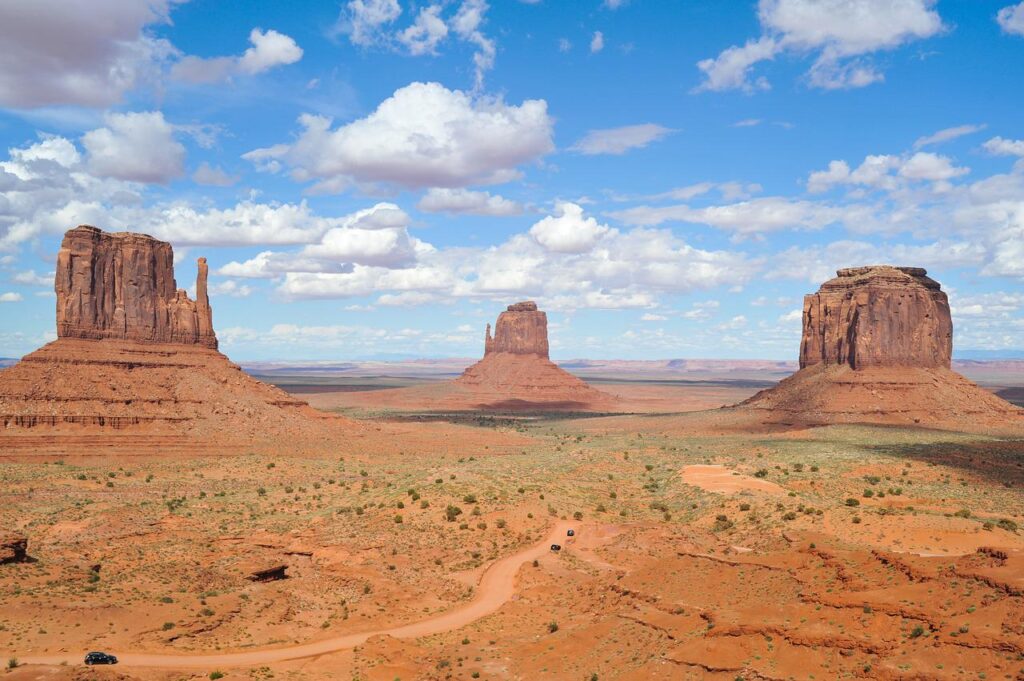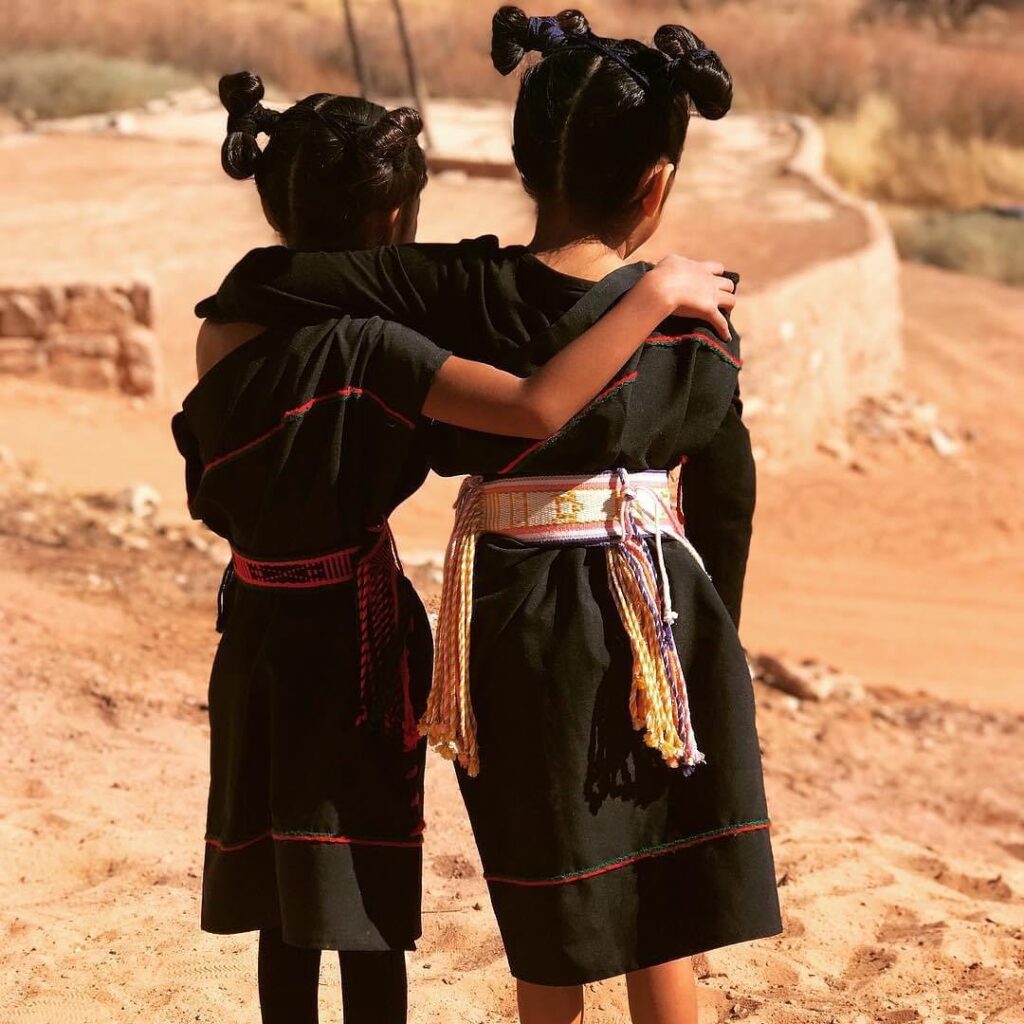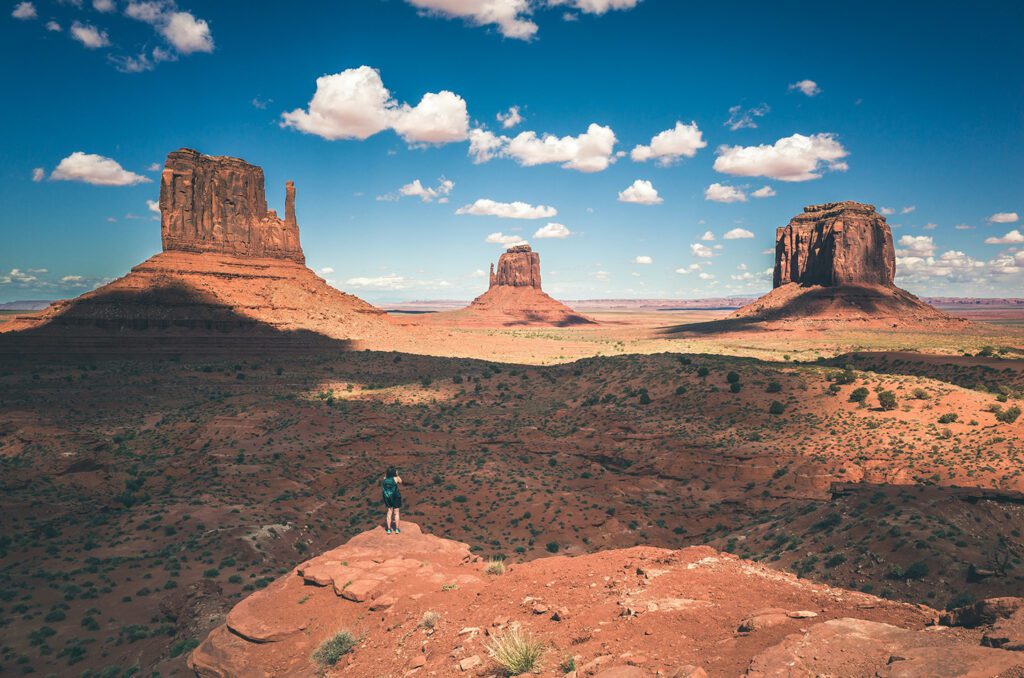Recently updated on March 5th, 2025 at 10:37 am
Stillness hangs in the hot air. Countless miles of red-orange earth, rock pinnacles and sandstone buttes (up to 1,000 feet-tall) fill your vision. Welcome to Monument Valley Navajo Tribal Park. Situated on the border of Utah and Arizona, approximately 180 miles from the Grand Canyon. And for the indigenous ‘Diné’ (Navajo Indians) who live here, ‘Tsé’Bii’Ndzisgaii’ – meaning Valley of the Rocks – is the proper name for their home.
GET INSPIRED BY: Best of Canyonlands tour (USA)
How did Navajo Tribal Park form?


The archetypal image of the US’ Midwest, Navajo Tribal Park takes ‘raw and rugged beauty’ to another level. You might recognise it from films like Stagecoach, Fort Apache and She Wore a Yellow Ribbon. Plus the desert running scene in Forrest Gump (starring Tom Hanks).
Sediments formed into a lowly basin thanks to 50 million years’ worth of erosion on mountains. Then, further erosion stripped away the softer materials and pushed what remained upwards due to pressure from below the earth’s surface. The result is a masterpiece of mother nature and one of the most photographed sites on the planet.
But hidden between the rocks, shrubs and arrow-straight roads, rock engravings, hogan mud huts and fossils, local Navajo have stories to tell…
History of indigenous life in Navajo Tribal Park
How did a small settlement in northwest New Mexico (in 900 AD) evolve into a 71,000km nation with over 250,000 people and the most sophisticated indigenous Indian government ever seen?
To start: from 900 to 1525 AD, Navajo Indians traded flint and moccasins with Anasazi and Pueblo peoples across the southwest. And thanks to their smooth sales skills, they expanded into northeast Arizona and southeast Utah in the 16th century.
Battling Spanish colonizers
But like all indigenous Americans, their land is sacred. So when Spanish colonizers threatened their home, many Navajo rallied for their indigenous friends and fought in The Pueblo Revolt of 1690: the most successful indigenous uprising against colonial intruders.
The scorched earth war (1863)
Navajos will never forget 1863. For refusing to accept confinement, Colonel Christopher “Kit” Carson launched a brutal scorched earth war on Navajo lands. Villages were destroyed; crops were burnt; livestock was slaughtered. Families were broken as 10,000 Navajo were forced to walk 300 miles to New Mexico to be confined at the Bosque Redondo Reservation.
Relief at last – The Navajo Treaty (1868)


After yearning their homeland every minute, the Navajo people negotiated a return home. They signed a treaty with the US government in 1868: agreeing to cease war against the United States and, in return, let U.S. officials live within their lands and manage the construction of railroads. The government provided farming equipment and seeds, 15,000 sheep and goats, and 500 cattle. Plus laid out other rules and regulations. For example: that each person owns 160 acres.
Although a little different from before, the Navajo were finally home – with many in Navajo Tribal Park. And just a few years later in 1884, they added Utah to their territory. Momentum was building.
The Navajo Code Talkers (1942)
The Navajo were part of a brilliant success story from World War II. With a touch of genius, they created a unique code based on their unwritten Navajo language to communicate during the marine war in the Pacific. 29 ‘Navajo Code Talkers’ assigned a Navajo word to a military tactic – sending 800 undetected messages that the Japanese could not decipher – inspiring the U.S. Marines to victory.
RELATED CONTENT: The one-of-a-kind trip that celebrates Native American history
A sophisticated tribal government is born


The Navajo people kept rising to challenges. When their influx of land oil sources enticed the US government (looking to cash in), they formed a tribal government in 1923. This developed into the most sophisticated indigenous American government in existence by 1991 – with executive, legislative and judicial systems. And to stay true to their culture, everyone spoke Navajo language.
For the cherry on top… Native Americans were granted citizenship in 1924. Finally, their presence as symbols of cultural heritage was recognised… and the Navajo people’s resilience and authenticity were largely to thank.
How can I explore Navajo Tribal Park, and other indigenous communities?
Bucket-list adventures into the indigenous US need meticulous planning. That’s where Trafalgar comes in; because we handle all the details. All you need to do is pack.
On a Best of Canyonlands tour guests can look forward to a scenic 27km jeep drive around Navajo Tribal Park with a local Navajo guide explaining all that unfolds. Like all our tours, we aim to travel responsibly, which is why all proceeds are used by the local community to support indigenous reservations. Later, you’ll enjoy a traditional dinner (just wait until you try Navajo tacos) accompanied with traditional music and dancing.
RELATED CONTENT: Beyond the tourist traps: How Trafalgar helps you feel connected to local culture
Elsewhere in the US, you can delve into indigenous reservations and national parks on Trafalgar’s Native Trails of the Dakotas tour, where Sioux tribe members are bursting to show you their ancestral traditions and more.
Did you enjoy reading about Navajo tribal park and its indigenous communities? Feel free to ask us any questions in the comments below!